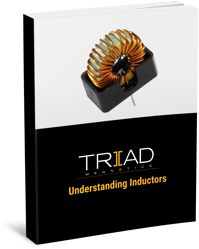Numerous technologies rely on chokes or inductors to deliver, alter, and filter electrical current. Understanding the difference between chokes and inductors is essential when designing devices and machinery that rely on electrical power. These electrical components each suit specific applications.
Chokes
.jpg?width=250&name=C-24X%20retouched%20(1).jpg) A choke is a type of inductor, but its application, function, and design differ from other inductor designs. Typically, this electrical component features a donut-shaped core with an insulated coil wrapped around it.
A choke is a type of inductor, but its application, function, and design differ from other inductor designs. Typically, this electrical component features a donut-shaped core with an insulated coil wrapped around it.
As the name implies, a choke cuts off or restricts high-frequency alternating current (AC). It only permits direct current (DC) to pass through its conductor. A choke eliminates AC and allows only DC currents to a load resistor or other load components.
Chokes protect insulation from damage caused by steep rises in current in circuits by facilitating a gradual rise and fall of current instead. Chokes can also break down voltage, allowing transient voltages across fluorescent tubes by keeping gas voltages from exceeding system voltages.
Inductors
.jpg?width=250&name=FIT44-1%20(1).jpg) An inductor is a principal electronic component similar to a choke, but they are not interchangeable—simply put, all chokes are inductors, but not all inductors are chokes. Inductors provide various functions but primarily store electrical energy from currents as a magnetic field. They contain a magnetic core wrapped with an insulated coil and typically are one of the largest electronic device components.
An inductor is a principal electronic component similar to a choke, but they are not interchangeable—simply put, all chokes are inductors, but not all inductors are chokes. Inductors provide various functions but primarily store electrical energy from currents as a magnetic field. They contain a magnetic core wrapped with an insulated coil and typically are one of the largest electronic device components.
Numerous applications rely on inductors, including:
- Filters: Inductors filter frequencies by raising impedance as the frequency rises.
- Sensors: Inductors can sense proximity with another object without making physical contact. This detection occurs because the magnetic fields of the inductor and the object interact in a process known as induction.
- Transformers: Transformers incorporate inductors for step-up and step-down processes. Arranging multiple inductors with the same magnetic field creates a transformer.
- Motors: Inductors produce the motor shaft's rotation using their magnetic field. The inductor serves as a control to increase and decrease speed using the power supply.
- Energy Storage: Inductors temporarily store electrical energy in a magnetic field. Computers use inductors to keep circuits energized and in switching power supplies.
Main Differences Between Inductors and Chokes
Many applications rely on inductors. When the inductor offers signal filtering, it is considered a choke. Although the two may seem interchangeable, there are several distinctions between them. Inductors can generate magnetic fields and can also store energy within magnetic fields. A choke's primary purpose is to remove AC current and pass DC current. Radiofrequency (RF) chokes rely on increasingly larger inductor sizes to block low-frequency signals.
Inductors and Chokes From Triad Magnetics
At Triad Magnetics, our experienced team uses the latest advances in magnetics manufacturing technology to deliver inductors and chokes that exceed performance expectations. We hold our products to the highest standards with inspections, shipment audits, and failure analysis. Our magnetics solutions comply with all relevant industry standards and international regulations, including UL and CSA.
We have served a range of industries with innovative magnetics solutions for over 75 years. From our warehouse in Perris, California, and manufacturing facilities in the Philippines, China, Taiwan and the US, we deliver industry-leading custom and standard magnetic products.
Our professional logistics capabilities and a comprehensive global network of suppliers allow us to offer the shortest lead times in the industry on more than 1,000 magnetics products.
To learn more about inductors, download our eBook, “Guide to Inductors.” For more information about our solutions, contact us or request a quote today to see how inductors and chokes from Triad Magnetics can help your project.







.png?width=259&height=820&name=Chokes%20vs.%20Inductors%20Whats%20the%20Difference%20(1).png)

